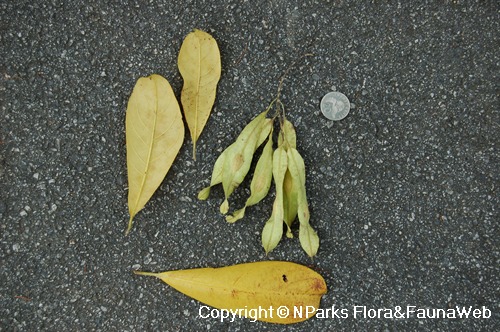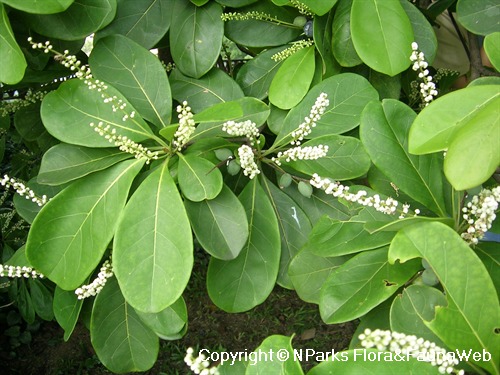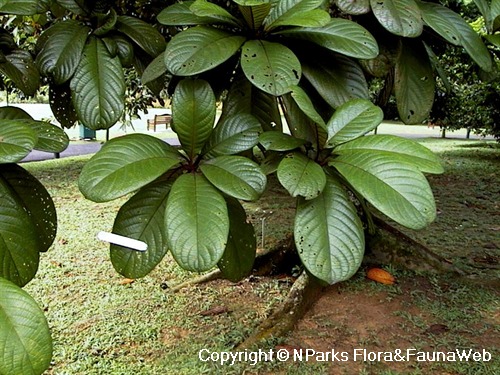
Back
Terminalia phellocarpa King
| Family Name: | Combretaceae |
| Common Name: | Pig's Mango, Mempelam Babi, Pelawei, Jelawei, Pauh Kijang |
Name
Classifications and Characteristics
| Plant Division | Angiosperms (Flowering Seed Plants) (Dicotyledon) |
|---|---|
| Plant Growth Form | Tree (Medium (16m-30m)) |
| Lifespan (in Singapore) | Perennial |
| Mode of Nutrition | Autotrophic |
| Maximum Height | 20 m |
Biogeography
| Native Distribution | Sumatra, Malaysia, and Singapore |
|---|---|
| Native Habitat | Terrestrial (Primary Rainforest, Freshwater Swamp Forest) |
| Preferred Climate Zone | Tropical |
| Local Conservation Status | Native to Singapore (Extinct (EX)) |
Description and Ethnobotany
| Growth Form | It is a tree up to 20 m tall with a fine-leafed crown. |
|---|---|
| Foliage | Its spirally arranged, stalked leaves have almost leathery leaf blades that are oval to drop-shaped, and 3.5–13 by 1.5–6.4 cm. The new leaves have rose-red veins on the undersides of their leaf blades. |
| Flowers | Its stalkless flowers are greenish-white, unpleasant-smelling, and found in 3–4 cm-long shoots at the leaf axils. |
| Fruit | Its mango-shaped fruits are green ripening to golden-yellow, slightly flattened, and 5–7.6 by 4–5 cm, with distinct, curved points. |
| Habitat | It grows in swamp forests at low altitude. |
| Associated Fauna | Its flowers are insect-pollinated. Its fruits are dispersed by water. |
| Cultivation | It can be propagated by seed. |
| Etymology | Latin terminus, end, referring to the leaves being borne at the ends of the twigs; Greek phellos, cork; Greek karpos, fruit, referring to the corky layer of the fruit |
| Ethnobotanical Uses | Medicinal: A concoction of the roots is taken for boils, while the leaves are applied as poultices at the same time. |
Landscaping Features
| Landscaping | It is suitable for planting in parks for its attractive crown and fruits. |
|---|---|
| Desirable Plant Features | Ornamental Fruits, Ornamental Form |
| Landscape Uses | General, Parks & Gardens, Small Gardens, Riverine, Pond / Lake / River, Marsh / Bog |
Fauna, Pollination and Dispersal
| Pollination Method(s) | Biotic (Fauna) |
|---|---|
| Seed or Spore Dispersal | Abiotic |
Plant Care and Propagation
| Light Preference | Full Sun, Semi-Shade |
|---|---|
| Water Preference | Moderate Water |
| Plant Growth Rate | Moderate |
| Rootzone Tolerance | Moist Soils, Waterlogged Soils (Drains Site) |
| Propagation Method | Seed |
Foliar
| Foliage Retention | Evergreen |
|---|---|
| Mature Foliage Colour(s) | Green |
| Mature Foliage Texture(s) | Leathery |
| Foliar Type | Simple / Unifoliate |
| Foliar Arrangement Along Stem | Alternate, Spiral |
| Foliar Attachment to Stem | Petiolate |
| Foliar Shape(s) | Non-Palm Foliage (Obovate, Oval) |
| Foliar Venation | Pinnate / Net |
| Foliar Margin | Entire |
| Leaf Area Index (LAI) for Green Plot Ratio | 3.0 (Tree - Intermediate Canopy) |
Floral (Angiosperm)
| Flower & Plant Sexuality | Bisexual Flowers |
| Flower Colour(s) | Green - Light Green, White |
|---|---|
| Flower Grouping | Cluster / Inflorescence |
| Flower Location | Axillary |
Fruit, Seed and Spore
| Mature Fruit Colour(s) | Yellow / Golden |
|---|---|
| Fruit Classification | Simple Fruit |
| Fruit Type | Fleshy Fruit , Non-Accessory Fruit |
Image Repository
Others
| Master ID | 1892 |
|---|---|
| Species ID | 3185 |
| Flora Disclaimer | The information in this website has been compiled from reliable sources, such as reference works on medicinal plants. It is not a substitute for medical advice or treatment and NParks does not purport to provide any medical advice. Readers should always consult his/her physician before using or consuming a plant for medicinal purposes. |





_lowres.jpg)


